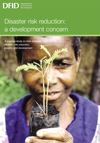 |
Disaster
risk reduction: a development concern |
Disasters
should be a core development concern
Disasters hold back development and progress towards achieving the Millennium
Development Goals (MDGs). Yet disasters are rooted in development failures.
This is the core rationale for integrating disaster risk reduction into development.
Disasters hold back development
Many countries are not on course to meet MDG1, the prime goal of halving extreme poverty and hunger by 2015. Country progress reports on MDGs frequently note progress on MDG1 being affected by disasters. In many cases, increases in numbers below poverty thresholds appear in aggregate national statistics following a disaster.
Disasters – including the everyday small-scale ones that go unnoticed by the outside world – affect poverty reduction in several ways. They have macroeconomic impacts, directly through physical damage to infrastructure, productive capital and stocks, but also indirectly and in the longer term by affecting productivity, growth and macroeconomic performance. These hit the poor hardest for several reasons. Loss of tax revenue and diversion of resources into disaster response has fiscal impacts affecting state provision of social services, while food prices often increase.
Moreover recent studies
suggest that both governments and donors tend to fund disaster relief
and rehabilitation by reallocating resources from development programmes. Although
the impact of any such reallocation is difficult to measure as it is unrecognised
in official figures, it can be expected to affect the poor disproportionately
through adverse effects on poverty reduction efforts.
Locally, impacts on poverty and food security can be much more severe and may not appear in national statistics. Disasters stretch coping strategies to breaking point and have long-term effects on livelihoods. High frequency hazards such as drought trigger immediate food crises, but can also have longerterm ‘ratchet’ effects which impede recovery in interim periods, especially when combined with other pressures such as HIV/AIDS, poor governance and conflict.
Disasters also slow down progress towards the remaining MDGs. For example:
- Disaster-hit
families often fail to send children to school, while schools may
be closed down by
earthquakes or floods (MDG2). - Disasters leave
women and girls – including mothers – with heavier responsibilities
and workloads and often poorer health. Disasters have also been associated
with increased domestic
violence and sexual harassment (MDG3&5). - Children are in greater danger in floods and drought, through drowning, starvation and disease (MDG4).
- Disasters directly
cause disease and damage to health infrastructure, while indirectly
lowering
disease resistance by heightening poverty and malnutrition. They may also lead women and girls to resort to sex work and risk HIV infection (MDG4&6). - Disasters can increase rural-urban migration, and in cities disproportionately affect slum dwellers (MDG7).
- Storms and tidal
surges set back gains from partnerships with small island states
(MDG8).
Such diverse consequences tend to go far beyond the immediate impacts which make media headlines and international disaster statistics. This is one reason why their role in holding back development may be much underestimated.
2 Table : Examples of disaster impacts on efforts to meet the MDGs
MDG
|
Direct
impacts
|
Indirect
impacts
|
| 1. Eradicatee extreme poverty and hunger |
|
|
| 2. Achieve
universal primary education |
|
|
| 3. Promote gender equality and empower women |
|
|
| 4. Reduce
child mortality |
|
|
| 5. Improve maternal health |
|
|
| 6. Combat
HIV/AIDS, malaria and other diseases |
|
|
| 7. Ensure environmental sustainability |
|
|
| 8. Develop
a global partnership for development |
|
|
| ALL MDGS |
|
* Though
data are scarce, a number of studies suggesting a surge in domestic
and sexual violence against women in the wake of disasters are cited
in, for example, PAHO (2004), EIIP (1998), Wisner et al. (2004:16),
possibly resulting from heightened intra-household tensions.
Table 3: What disaster risk reduction can contribute
towards meeting the MDGs
MDG
|
Examples
of what risk reduction can contribute
|
| 1. Eradicatee extreme poverty and hunger |
|
| 2.
Achieve universal primary education |
|
| 3.
Promote gender equality and empower women |
|
| 4.
Reduce child mortality |
|
| 5. Improve maternal health |
|
| 6.
Combat HIV/AIDS, malaria and other diseases |
|
| 7.
Ensure environmental sustainability |
|
| 8.
Develop a global partnership for development |
|
| ALL MDGS |
|